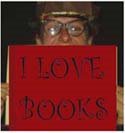 Say, Allen. 1993. Grandfather's Journey. Boston: Houghton Mifflin. 0395570352
Say, Allen. 1993. Grandfather's Journey. Boston: Houghton Mifflin. 0395570352Plot Summary
Say's grandfather is a dreamer and traveler. In this picture biography, he shares his life venturing from Japan to the United States, exploring the vast lands by train and foot. He returned to Japan to marry and bring his childhood sweetheart bride back to California to raise a family. Years of life bring a sense of being torn between his two homes.
Critical Analysis
This beautiful, simple biography shares a life of adventure, love and longing between two worlds. Say's grandfather is portrayed as a dignified, courageous, dreamer. The clothing is appropriate to the location of each setting. It is historically accurate and depicts the way that he adapts to various situations. For example, his casual western dress while exploring the farm fields; his western-style sweater while in his living room in California versus his Japanese robe sitting in his Japanese living room later; and traditional robe that bears the insignia on his arm as the robe of his youth in the first painting. His glasses change as the years pass, as does his facial lines and features as he ages.
His daughter is portrayed in urban San Francisco dress while she departs their Japan village home and later wears traditional obi and robe in her wedding painting. The females in the book are appear unemotional and posed as a formal picture setting would be. The young daughter's doll is an Anglo girl on a stroller that was used at the time. She wears a short black haired bob and an expressionless face.
The paintings portray the landscape and environment of both city and countrysides, and evolve historical over the course of the twentieth century. The grandfather poses in front of the steam engine, barber shop, and steamboat which illustrates the time period without any mention in the text. The text illuminates his sense of being torn between two worlds with phrases such as, "my grandfather began to think about his childhood. He thought about his old friends."(p17) and "but he could not forget the mountains and rivers of California" (p25) and "The last time I saw him, my grandfather said that he longed to see California one more time." (p29)
On page 12, the author illustrates how he met different people he had never met before. "He shook hands with black men and white men, with yellow men and red men." In the painting for this page, the men of all 'colors' are all dressed as gentlemen with ties, vests and hats. It is unclear whether the author/illustrator created the text and images from old photographs he found or whether he reconstructed them based on stories, research and ideas. There is no author's note or explanation regarding the what he developed the story. The grandfather's name is never mentioned. His daughter (the author's mother) is referred to as 'his daughter' and 'young woman'. This detracts from identifying with the characters and is unfortunate he chose to leave them anonymous.
The story is obviously personal to the author. "When I was a small boy, my favorite weekend was a visit to my grandfather's house." (p24) Although it is possible that this grandfather, daughter, etc. are simply fictionalized characters seeking to tell the story of a Japanese man's journey to and from the United States. Either way, the story is lovely, the illustrations are simple and crisp which could even tell the story without text. Good for any age.
Review Excerpts
"Grandfather's Journey eloquently portrays a Japanese immigrant's travels to a new land. Exquisite watercolors portray vast landscapes along with intimate family portraits that communicate hope, dignity, sadness, and love. Say powerfully connects the personal and the universal to create a rare harmony of longing and belonging." http://www.ala.org/ALSCTemplate.cfm?Section=caldecotthonors&Template=/ContentManagement/ContentDisplay.cfm&ContentID=17490
"...at once a very personal tribute to his grandfather and a distillation of universally shared emotions. Elegantly honed text accompanies large, formally composed paintings to convey Say's family history." - Publishers Weekly
Connections
Other Allen Say picture books with various stories of Japanese American's experiences try these: Tea with Milk, Music for Alice, Home of the Brave, Kamishibai Man and Tree of Cranes.
Additional Information
1994 Caldecott Medal Winner


